How Heated Driveways Work
Warmzone offers both electric and hydronic snow melting systems. Electric heated driveways are fully
automated and maintenance free, while hydronic systems are also fully automated but require minor
maintenance on occasion. The reason that electric heated driveway systems are maintenance free is
that they have no moving parts. Once installed, these systems require no further attention. But
how do these systems work?
Heated driveways use three main components: The heating element, an activation device (snow sensor),
and controller/contactor panel (pictured below).
-
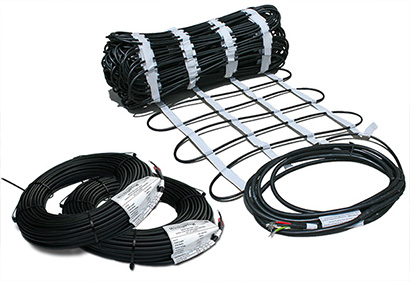
Snow melting heat cable and mat.
-
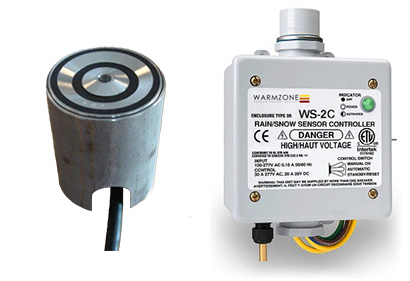
Ground and aerial-mount snow sensors.
-
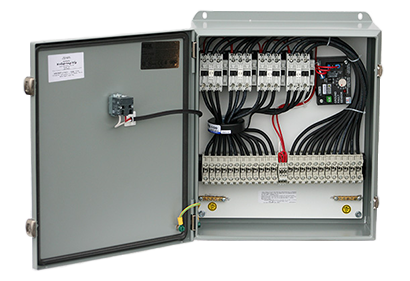
Contactor panel for snow melting system.
-
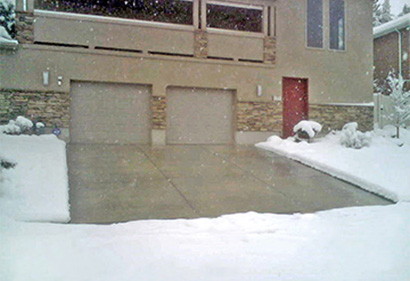
Heated driveway after a snowstorm.
Electric Driveway Heating Systems
Electric heated driveways utilize resistance heat cable to melt snow and ice. The mats feature heat cable
that is pre-spaced and taped so they can be quickly rolled out for easy installation. The cold leads from the cable
are over 16-feet long and are connected to the contactor panel. (Longer lengths are available upon request.)
The snow melting system also includes an activation device. Most residential installations use an aerial-mount
snow sensor; however, in-ground snow sensors are also available.
The snow sensor activation devices feature advanced technologically and rugged construction. The activation devices
detect both precipitation and temperature. When the temperature is below the adjustable set point,
which is usually set at 39 degrees Fahrenheit, and moisture is also detected,
the sensor signals the contactor panel and power is then sent to the embedded heating cable.
The response time with electric heated driveways is very rapid. The cable warms and quickly heats the driveway surface
as the first snow falls. As long as the snow continues to fall, the power continues to be sent to the heat cable.
After the snow stops, the pre-programmed "afterrun" safety feature kicks in,
keeping the system on just long enough to dry the surface and ensure that no
ice forms and the driveway is completely clear. Afterwards, the system shuts off. (View a
video
of a snow melting system in operation and the afterrun function.)
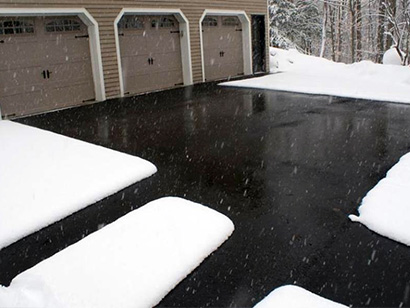 Heated driveway systems also feature manual override capability. This way the owner can turn on the system
if/when needed. For example, snow drifts may form or perhaps a pool of ice has formed in a shady area. The
heated driveway can be activated to eliminate these trouble spots and keep the driveway clear.
Heated driveway systems also feature manual override capability. This way the owner can turn on the system
if/when needed. For example, snow drifts may form or perhaps a pool of ice has formed in a shady area. The
heated driveway can be activated to eliminate these trouble spots and keep the driveway clear.
Because electric heated driveways are relatively simple, they are not difficult to install. But it is
important to have a licensed electrician wire the system to maintain a valid warranty. And while electric
heated driveways are relatively easy to install, the same cannot be said for hydronic systems.
Hydronic Heated Driveways
Hydronic heated driveways also utilize a heating element, activation device and controller, but these systems also require a dedicated "mechanical room" to house the water heater, pumps and manifold.Hydronic snow melting systems utilize a series of flexible polymer tubing as the heating element. Warmzone hydronic systems use Engel-method cross-linked polyethylene (PEX-a) tubing with an oxygen barrier. The construction of this premium tubing prevents corrosion of ferrous components to ensure a long life and optimum performance of the system. The tubing features the highest degree of cross-linking for the greatest durability and flexibility, and also offers the tightest bend radius (six times the tubing diameter) to help avoid kinks.
A mixture of hot water and propylene glycol (anti-freeze) is heated in the boiler and then a series of pumps circulates the liquid through the closed-loop Pex tubing embedded in the pavement (or under pavers).
The condensing boiler (water heater) can be powered by any energy source, including natural gas, electricity, oil, propane, wood, or even solar collectors. This can result in cheaper operating costs for hydronic heated driveways versus electric snowmelt systems. The hot water and anti-freeze mix also retains heat for a long time after the boiler shuts down, so the hydronic heating system can reduce energy use, adding to its efficiency and making it environmentally friendly. In addition to using the premier Pex tubing, Warmzone hydronic snow melting systems also feature some the industry's most efficient condensing boilers with an Energy Star Rating, as well as industry leading pumps and valves.
